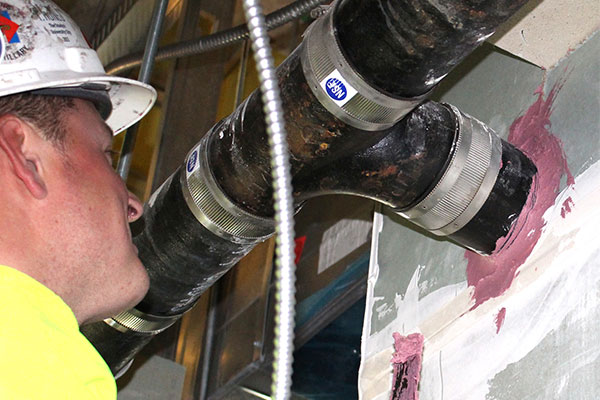Firestopping Materials & Why All Components Matter
Author: Beacon | July 25, 2024
For people fleeing a structure fire, especially in a high-rise building, the most valuable commodity is time. One way to maximize the amount available to them is to use effective firestopping materials.
An informative article in The Construction Specifier, titled “Firestopping Materials: Why All Components Matter,” highlights the value of these materials and explains that testing them as systems is essential. We’ve summarized the piece for you below.

When Time Is of the Essence
Fire is relentless in its attempts to reach all areas of a building. However, every minute that the right building materials can hold it in check is another minute for occupants to exit safely. Slowing the spread of flames and smoke also provides firefighters crucial time to reach anyone trapped in the building and determine the best way to fight the blaze.
Various types of firestopping materials make up what are called perimeter fire containment (PFC) systems. As the article notes:
“Today’s U.S. building codes require the firestopping materials installed in PFC systems to be tested to ASTM E2307, Standard Test Method for Determining Fire Resistance of Perimeter Fire Barriers Using Intermediate Scale, Multi-story Test Apparatus.”
The author also notes that the effectiveness of PFC systems is a double-edged sword. It protects lives and property, which is critical, but its success in doing so may be creating “a sense of complacency” due to the lack of catastrophic fires in high-rise buildings in recent years.
That complacency has led to issues like a trend of pre-insulated back pans not tested to the ASTM E2307 standard coming into the U.S. from overseas. Because they are panels, it’s difficult for inspectors to determine if the materials in them have adequate firestopping capabilities.
Protecting the Perimeter
Architects, engineers and field workers play vital roles in fire protection by specifying and properly installing “tested and listed” firestopping systems. Testing per the ASTM E2307 standard, the listing denotes that the system has passed the rigorous Intermediate Scale, Multi-story Test Apparatus inspection under extreme testing conditions.
A PFC system has several components, often including some or all of the following:
- Mineral wool insulation
- Hangers
- Mullion covers
- Backer/reinforcement support
- Firestop sealant/sprays
These materials are designed and tested to work together to protect a building’s perimeter.
Mineral Wool and System Testing
A crucial point made in the article is that materials are tested together as part of the PFC system, not individually. That means if one system component is swapped for another untested item, the whole system must be assessed with the new material.
The author uses the example of mineral wool — a product that stands up to heat and flame and maintains its structural integrity. Specifically, a version tested to the ASTM E2307 standard can withstand direct flame impingement and temperatures exceeding 1,800 degrees Fahrenheit while retaining stability. But if an untested product is used in place of a tested version in an assembly, a lab must retest the entire assembly.
Why would this type of switch be made? One reason is that mineral wool has other valuable properties besides firestopping. They include its ability to reduce noise, repel water as a rain screen or absorb it in hydroponic settings. That might lead someone to specify a different mineral wool product to improve one of those areas, unaware of the impact on firestopping capability.
The Risks of Component-Based Testing
System-based testing clearly increases the effectiveness of PFC systems in U.S. buildings. Unfortunately, some product manufacturers are advocating for component testing, which the author believes is not as effective.
She emphasizes that component testing could lead to a scenario where, for example, the mineral wool in a PFC resists flames but doesn’t have the structural integrity to stay in place as curtain wall components start to fail.
Safety Must Be the Top Priority
Component-based testing suggests testing each component individually. System testing relies on the total performance of the assembly of components holding up to the test criteria. Firestopping systems exist to save lives. Consequently, there is too much at stake to cut corners.
While it is more involved, system-based testing ensures PFCs will function as designed when lives are in the balance and every second counts.
We encourage you to read the full article here and learn why using perimeter fire containment systems for high-rise construction tested by authorities like Underwriters Laboratories (UL) is critically important.